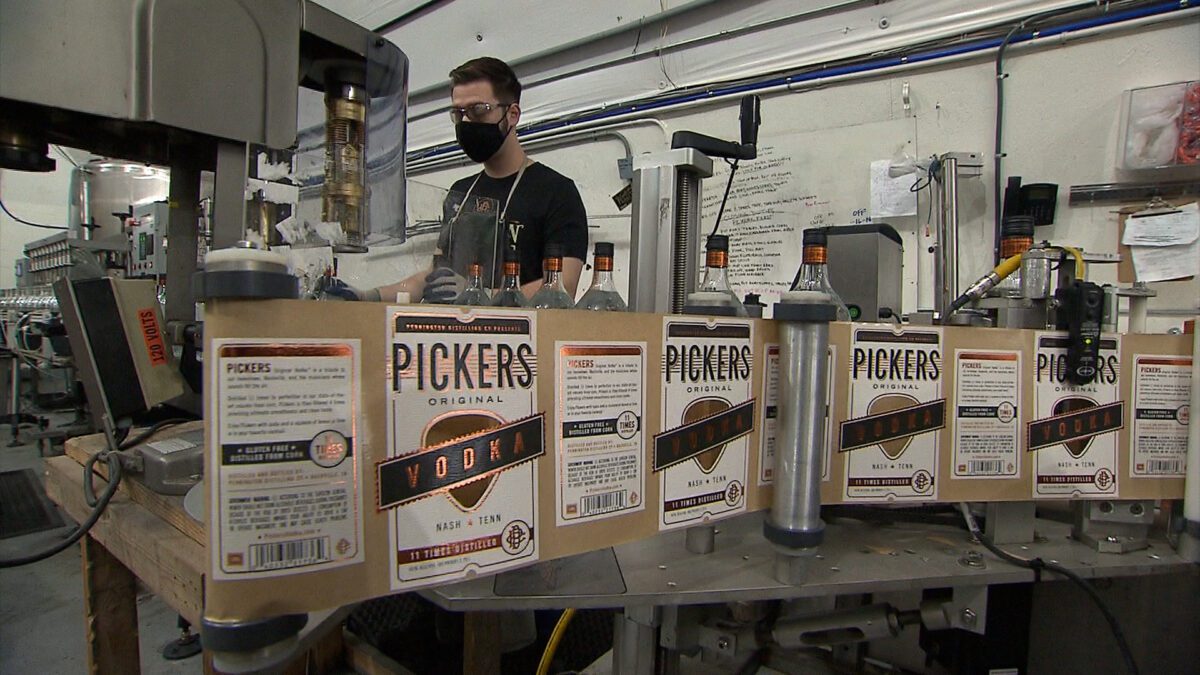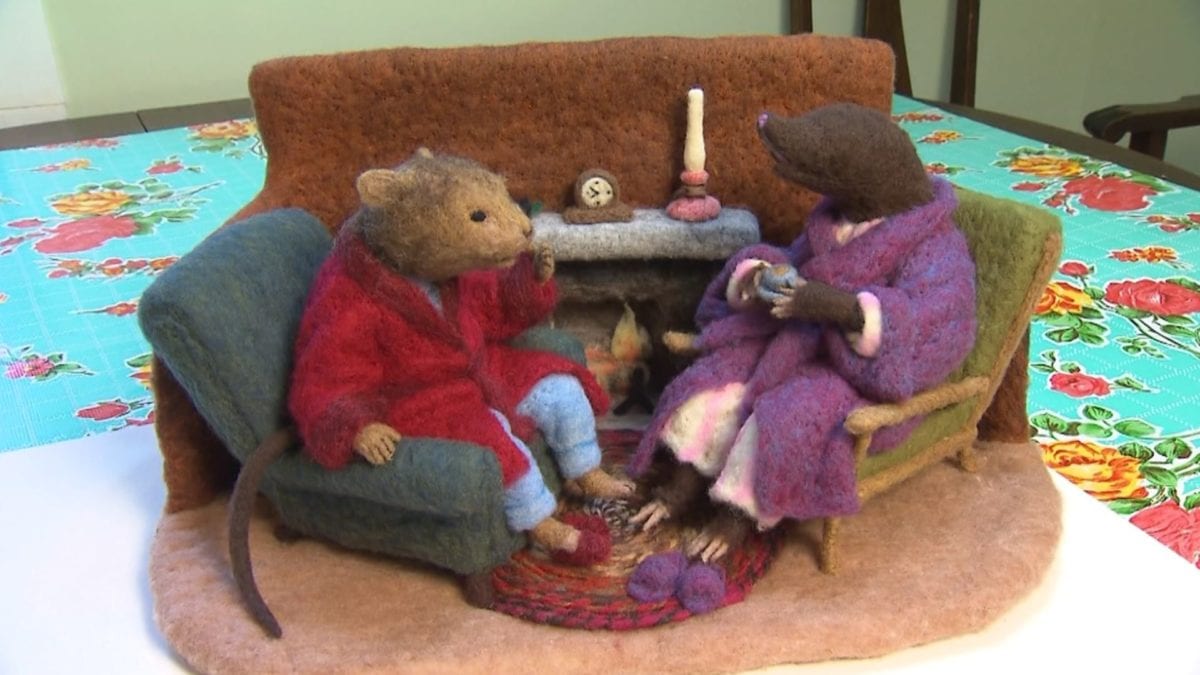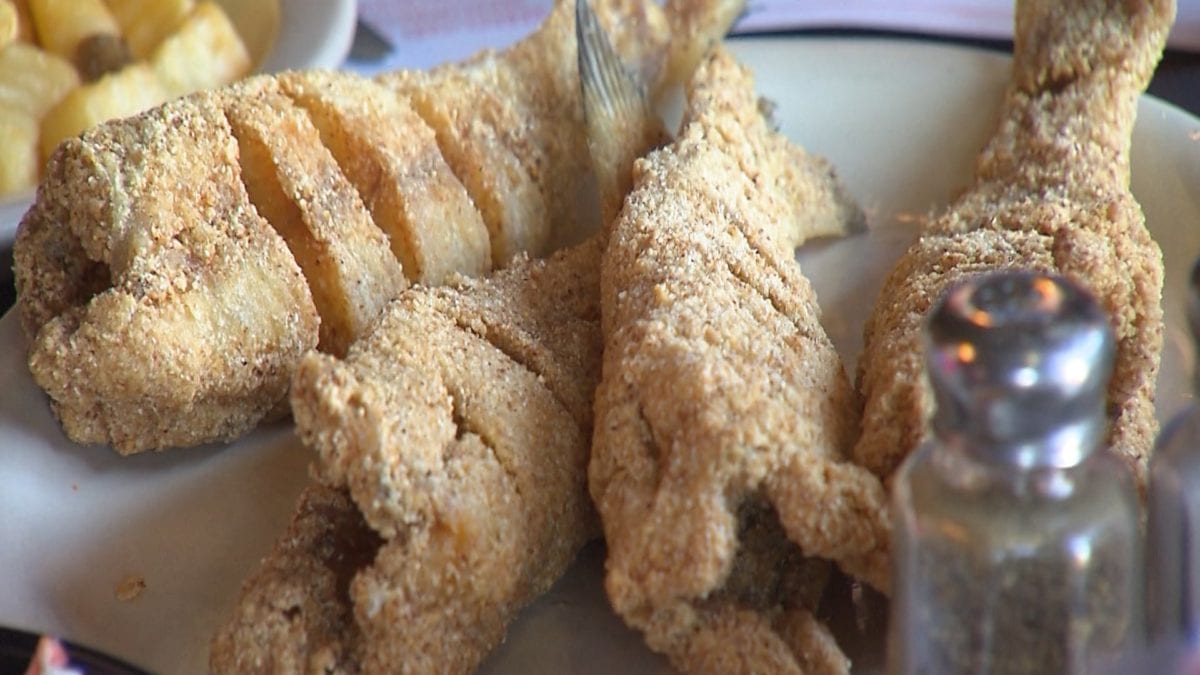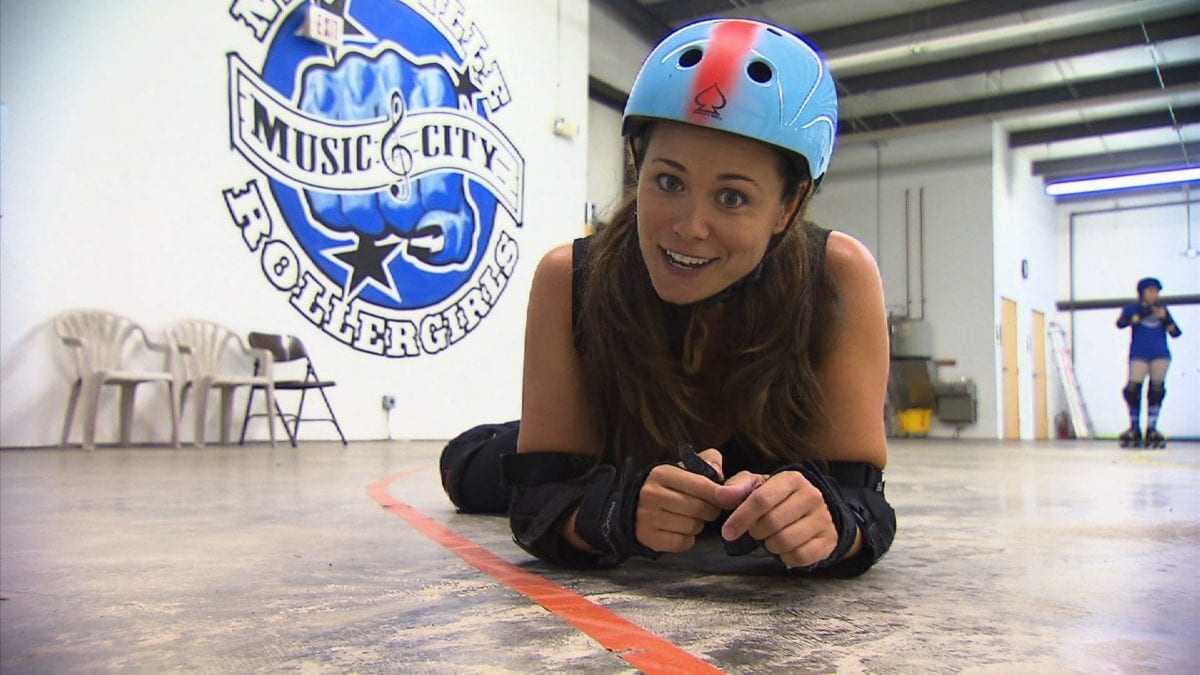- This time on Tennessee Crossroads, we have the spirited story behind Pennington Distillery in Nashville. Then a fish tale about a popular restaurant near Shiloh. We'll meet some daring young ladies on roller skates and meet an artist whose media is felt. Hi everybody I'm Joe Elmore. That's the lineup for this Tennessee Crossroads. Welcome. Tennessee whiskey has never been more popular. And with the growing number of new craft distilleries in this state, well, people are embracing it more than ever. Laura Faber takes us to a Davidson County distillery that is making award-winning spirits and has a great love story behind it.
- [Laura] There hasn't been a better time to be making whiskey in Tennessee. First of all, it's legal again. Second, more people than ever are rediscovering this spirit.
- Not just your males, it's your females. It's all, you know multiple genders and races and internationally. I mean, American whiskey is growing outside the US as well. You know, I think we used to be seen as a subpar product to scotch. You know, American bourbon and Tennessee whiskey. Think people now realize oh no, it's just as complex. It's just as good.
- [Laura] Jeff and Jenny Pennington are the owners of Pennington Distilling Company based in West Nashville. Once the state law changed in 2009, allowing legal distillation again, they knew they had to give their dream of making whiskey a chance.
- Came across some photos the other day of Jeff in this room, when it was stark white, there wasn't one piece of equipment. There was not one employee. I mean, it was just the two of us. And you know, those moments really put it in perspective to look back and just think how far we've come and how we've built this great team around us and a whole portfolio of brands now.
- [Laura] It's a real love story. Jeff and Jenny were high school friends from Franklin. They then worked for competing liquor distributors after college and hid their romance for a long time. Eventually they married and are now on the journey of a lifetime. Their own brand of whiskey was the goal but that takes five to seven years.
- We knew we wanted to make whiskey. We needed something we could use younger whiskey in. So we thought, okay if we create like a Tennessee whiskey cream liqueur, it could allow us to use younger whiskey while we're letting it age.
- It's cashflow. You know, getting into the whiskey business is not easy. It's an expensive proposition. If you wanna do it what we think is the correct way and tradition. You know, our values here is craftsmanship, quality and heritage. You know, patience is important in whiskey. I've tasted a lot of craft whiskeys all over the country that said they do this or they do that or they, you know, to try to age it faster. I've yet to taste anything myself that cheats time.
- [Laura] They also distilled two types of vodka along with many vodka products. The Pickers brand has rigging on the side of the bottle to mimic guitar frets, an ode to Music City. The premium Walton's Vodka was named after Jenny's late father.
- One day when we decided to actually get in the vodka business, we purchased the vodka still and everything. And we said, you know, we really could try to make Walton's finest vodka in a weeded recipe, that was what he preferred to drink. It definitely has a different taste profile. So we went through 100 prototypes it felt like. And he had a book, he'd write it down, rate 'em and finally on the 99th one he said, oh he would compare it to his vodka of choice. And he thought he was once again, nope, the Walton's isn't there. I'm selecting the one I always pick. And he realized that he had chosen the Walton's over what he had drank for years. That was an exciting moment.
- [Laura] The goal has always been to create original craft spirits that reflect the character of Nashville and Tennessee. They give back a portion of revenue to local charities that support musicians, cancer research, animals and more. And all their grain comes from the local Renfro farms.
- [Jeff] We get our Tennessee white corn and our red winter wheat and our white cereal rye from them. And then when we're done with it, the mash goes right back to local farmers to feed hogs and cows.
- [Laura] Nearly every part of the process happens on site. The grain is milled here then cooked, distilled, aged and bottled. Carter Collins is the master distiller and tour guide.
- Step one, we're taking grain and we're grinding our grain in. Putting it in our cooker where we're able to heat it. And that enables us to convert the starches in the grain to formidable sugars.
- Okay, after this, it goes here.
- We'll transfer it into our fermenters then we'll add yeast and they'll sit in the fermenters for three to four days. The yeast will consume those sugars and the by-product is alcohol and CO2.
- All right, from here it goes to the beautiful still.
- When we put in the still, this enables us to extract the alcohol from the mash. By putting in the steel, heating it up the alcohol evaporate, come up, condense and what comes out at the end is new make whiskey. So this is what goes in the barrel.
- Okay. And it's white, no color yet to it, nothing.
- No color. The barrel will give it the color over time.
- We hope when someone buy, picks up a bottle at Kansas city or LA or Chicago or Louisville, that they're not just buying another product. They're buying a little bit of Nashville and a piece of Nashville and Tennessee. And so when they come through, we wanna make them not just a fan of our brands but a fan of our industry and a fan of our heritage.
- [Laura] It's a love story that keeps on giving and you can experience it too.
- Thank you, Laura. You know, it takes something special to attract folks to a remote dining destination. Well, how about delicious catfish, a clever name and a scenic view of the Tennessee River. That's what Hagy's Catfish Hotel has offered for more than 75 years. The Tennessee River flows about 650 miles through four Southeastern states including of course, Tennessee. It's been a vital transportation corridor for flat boats, steam boats and well now tug boats pushing barges to faraway ports. In the early 1860s, the river played a major role in the war between the states. The river has also been an historical source of food. Thanks in part to whiskered creature, known as the catfish. And that brings us to the Hagy family of Harden County. Back in the 1930s, Norbin Hagy decided to turn his passion for entertaining folks with his catfish into a restaurant business, right here on the banks of the Tennessee River. Thus, a Tennessee catfish legend was begun and still thriving today. A lot of guests would end up spending the night at the Hagy's cabin, So the Catfish Hotel name was coined and stuck like batter to a fresh filet. The fish come from farms nowadays but the tradition is alive and tasty and prospering thanks to managers, Barbara and Joey McAfee who've almost grown up in the business.
- My first job was busing tables and I went from there to washing dishes and then eventually cooking.
- [Joe] So you've done everything.
- I've done about everything.
- It's funny how the children come, you know, when they're in highchairs then they come and bring their family, which are babies and I think oh my goodness. Just a lot of generations have passed through.
- [Joe] As you walk into the Catfish Hotel some of the family history is displayed on the wall.
- This is the Hagy family. And that's the 75th anniversary of the place.
- [Joe] So what's the secret that brings customers back and back again, after more than seven decades?
- Delicious catfish and mouthwatering hush puppies. Homemade. It's kind of a secret recipe but staff in the kitchen just do a great job. Just bread it and then deep fry it. We have the whole fish, which is all you can eat. And we have fried catfish filets. And we also have broiled fish with lemon pepper seasoning or Cajun.
- [Joe] Oh, and yes, even catfish tacos. No matter how they order it, regular customers travel quite a few miles to get it. Like this couple from Olive Branch, Mississippi
- [Woman] We get hungry for fish so we just get in the car and come down here and eat and go home. And we do it all the time. Maybe once a month.
- [Joe] Well, it must be good if you make that effort.
- It is very good and it's always the same. We've never gotten any, anything bad. It's always good.
- Now while you enjoy your meal, you might just encounter a legend of the Catfish Hotel. And I'm talking about none other than, Elmo, ghost of the river bank. As the story goes, he perished on a riverboat in the late 1800s, was buried here on the river bank, and that was that until the Catfish Hotel came along.
- I don't know what it is, but he kind of likes the bathroom. And we had a customer that came out of the men's restroom. And he said, his dad always puts his hand on his shoulder because he was always in everybody's way. And he just felt his dad's hand on his shoulder, down the hall. And then he got in the dining room and there sat his dad and he thought, who was that? Said, I felt a hand on my shoulder. So that was kind of spooky.
- [Joe] Chances are you won't see, hear or feel size of Elmo on your visit. The only guarantee is a friendly welcome, a view of the river and all the fish you can possibly consume. Of course they have other menu choices like steak and chicken. But it's catfish that put the place on the map and catfish that makes friends out of customers.
- All right. Okay.
- A lot of friendships over the years with our customers. And we just want them to come and enjoy their selves and make some delicious food and get to know everybody.
- Oh and while that name, Catfish Hotel is quite catchy, it has been cause for confusion to a few visitors.
- I think maybe two or three times they've brought in their luggage looking for a room to spend the night. So I tell them just the catfish spend the night and then they're not here long.
- Fish filet with fries. Chopped steak. You have a good day now.
- Our next story is about a hobby that's not for everyone. It combines comradery with exercise, which is great. But the weird part is spinning around a concrete track crashing into people at high speed, unless you're into that kind of thing. Gretchen Bates was, at least for one day, with the Nashville Roller Girls.
- [Announcer] Here in the heart of beautiful downtown Nashville, Tennessee. Allow me to present to you the Music City All-Stars.
- There was maybe one or two moments during training where I was like, hmm is this a good idea? Am I gonna like kill myself? But no, it's so fun. That's all you're thinking about.
- [Gretchen] The fun that Deja Brandeis is referring to might be considered a bit intense for some but that's just how these ladies roll. Meet the Nashville Roller Girls. Sugar and spice. Heavy on the spice, but they really are nice.
- When people started to find out, it was like, wow, you don't look mean enough or you don't look big enough. Or I thought you were so nice.
- [Gretchen] Roller Girls President, Jennifer Smith, like all the members of the women's Flat Track Derby Association, takes the bumps and bruises in stride. But it's been a lot harder overcoming the sports checkered past.
- Well you know what? I'm a nice person. I'm a nice person here. I'm a nice person at derby too, but I'm really focused on what I'm doing at work. I'm really focused on what I'm doing at derby too just in a slightly different way. As far as misconceptions, always somebody saw it when they were a kid and that's cool, but it's really different now. And I think it's, it's much more professional. It's much more above board. And family friendly
- [Gretchen] The proof of that friendliness is in the fans. All kinds of fans, who battles similar misconceptions.
- I think there's a lot of stereotypes out there about who actually comes and watches this, but actually there's a little bit of everybody. I know a lot of my friends that I've told about it they're like, oh only certain people go to that. And it's not true. Everybody's here.
- [Gretchen] And like the fans, the Roller Girls hail from a wide variety of backgrounds.
- There really isn't one type of person who gets into roller derby. Professional type women. We have a CFO. Myself, I'm the head of the film department at the Art Institute. We have stay-at-home moms. We have bartenders. We have everybody you could imagine. All shapes and sizes from all different backgrounds. And we all just sorta mesh together.
- [Gretchen] More like mashed together. So it's obvious, often painfully obvious, that this is a contact sport but there is a method to the madness. Jennifer gave us a crash course in roller derby rules. The jammer actually is the physical person that scores the points. And there's one on each team at a time. And on the track, they're lapping the pack, which is either trying to help her or hinder her depending on whether they're on her team or not. And the first pass is to establish control over that jam. So you do that by becoming lead jammer and that jammer can keep the jam going up to two minutes. She can call it off whenever it's most advantageous to her team on the second and subsequent passes through the pack the jammer is scoring points for each opposing player that she passes. And her blockers are helping her and the opposing blockers are trying to stop her. And then there's things like penalties that come into play and clock management. You have different strategies at different points in the game, depending on whether you're winning or you're losing. There are legal zones of engagement and there are legal blocking zones. So for example, I can engage someone from my hip and shoulder. It's not okay for me to engage in this manner with my arm away from my body. So kind of like soccer in that aspect of it.
- [Gretchen] It looked like soccer on steroids to me, but I decided to give it a shot and wound up taking one. On the track the roller girls give as good as they get, but off the track, they give even more.
- For every bout we select a local charity to work with and we advertise with our advertising, for the bout we advertise the charity and then we also give them money as well.
- We also do community service at least once a quarter when we go out and do something with Hands on Nashville or do something with National Public Television or other things that are kind of meaningful to our league members. It's good to have your face in the community for a lot of reasons, but it's also the right thing to do. It's nice that we're able to do that. Not everybody has had the fan support that we've had. We're fortunate that we've always had really good support here in Nashville. We hope that continues. Because it lets us do a lot of other really cool things for Nashville. You cannot have more fun in Nashville for the price of our ticket. You just can't. It's a good time. And it's family friendly. We do like go to great lengths to make it that way.
- It's exciting. I mean, it's gets your adrenaline pumping. It makes me want to do it actually.
- If somebody wanted to get involved but were nervous about it I would just tell them that I was too. I looked at it and I went I wish I had the guts to do that, but you do. You just have to try it.
- Come down for a great time. It's just a blast. These girls put their heart and soul into this and I love it.
- Next, we'll meet a sculpture, not of stone, not of metal, not even ice. You see Chris Armstrong sculpts felt. Yeah, I had the same question too. Rob Wilds found the answer though on a trip to Hickman County.
- That's the old coot.
- [Rob] Chris Armstrong may look like he's relaxing but he's really hard at work, looking for inspiration for his creations: works of art in felt.
- I sketch around a little bit and generally have these ideas for what will be endearing. And I collect a lot of old children's books, the old illustrators. So I get a lot of inspiration from them but they're really generic characters in a way. Although people, people will see a toad and they'll say, oh that's such and such toad. Or that's Mr. Toad. And I'd say, absolutely it is.
- [Rob] If it sounds to you like Chris enjoys his work you are absolutely right about that.
- It relaxes me, the needle felting. A lot of people come to me and they say, oh, I tried that and it was nerve wracking. It stressed me out. But the repetitive motion, I think, relaxes me.
- [Rob] Which is quite a change from Chris's 20 year career as an investigator working on death row cases for the federal public defender. When he retired from that stress, he picked up the craft he had set aside for a decade.
- I let it go. And I didn't pick it up for 10 years. When I retired I thought, yeah, I wonder if I could still do that. I can.
- [Rob] Yes, and not everyone can. It takes skill and patience and the medical plan.
- I'm pretty good at it. After poking wool, a couple of million, your aim gets pretty well. Although I do stick by myself sometimes. It takes a lot of patients and a current tetanus shot.
- [Rob] It may look like it's just a matter of poking the felt rather than your own finger but it's knowing where to poke and how often.
- If you poke it a million times, it becomes a sheet of felt. If you only poke it 50,000 times, it becomes a raccoon with a vest on. Chilling.
- [Rob] After Chris works his magic, a cat or a fox turn into works of art.
- They look like toys and a lot of craft fairs, I'll put out some that I don't mind if they're torn up for kids to play with. But they're not terribly durable because the wool is hanging on to itself by a thread, literally. So they're meant to be displayed and enjoyed.
- [Rob] Chris goes to a few crafts fairs each year and gets an almost universal reaction to his creations.
- Everybody smiles when they see that stuff. It's the wool lends itself to furry animals. I've always loved The Wind in the Willows when I was growing up and I started doing it for the children's festivals. So I make a lot of otters and raccoons. just critters dressed up like people, in unlikely situations. People get a kick out of these. They say it's very soothing.
- [Rob] Chris's inspiration comes from a soothing place. Winnie the Pooh and pals had their hundred acre wood and Chris has his own version filled with critters who look good, recreated in felt.
- [Chris] Turtles.
- [Rob] Turtles.
- Otters. I've made a few beavers and wood ducks.
- [Rob] Wood ducks.
- [Chris] They're beautiful. They look like they came from Mars or something.
- [Rob] Speaking of other worldly places and beings. Chris has recently branched out from the animal kingdom, into the world of myths and legends.
- I got a book of fairy illustrations from the 1900 and I started making fairies and people love fairies. There's all these subcultures of that run the gamut. And I put people's faces. I've used my daughter's face from the old photograph when she was a little girl some of my friend's faces. So I've started making humans with wings but humans.
- [Rob] It seems that whatever Chris creates strikes a cord.
- There's something nostalgic about all these well for me too. People remember The Wind in the Willows. They remember these books that they had when they were kids. And these are reminiscent of them.
- [Rob] Feelings of nostalgia and smiling faces, those are good things which Chris Armstrong plans to keep creating as long as his talent and his needle stay sharp.
- Well, I hate to say it, but it's about time for us to leave. However, I want to remind you to indulge in our website from time to time, Tennesseecrossroads.org. Of course follow us on Facebook and I'll see you next time.




